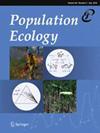通过迁移起始个体恢复东部地狱蛙(Cryptobranchus a. alleganiensis)种群
IF 1
4区 环境科学与生态学
Q4 ECOLOGY
引用次数: 0
摘要
尽管人们在水生系统的管理和保护方面做出了巨大努力,但淡水生物多样性仍在快速下降。东部地狱蛙是北美最具代表性的溪流两栖动物之一,也是溪流健康的哨兵,但在其分布的大部分地区,其种群数量正在迅速下降。常见的保护策略包括起步放流;然而,这种策略在重建地狱蛙种群方面的成功率以及最理想的放流方案在很大程度上尚未得到评估。我们利用在俄亥俄州几个流域释放的 205 只动物组成的队列,来评估为期 3 年的起头和重新引入工作的成功与否。利用 2018 年 7 月至 2021 年 11 月期间 25 次的 PIT 标签调查和捕获-再捕获模型,我们发现释放后 3 年的表观存活率为 0.162 ± 0.061,第 1 年的存活率较低(0.383 ± 0.058),而第 2 年(0.696 ± 0.086)和第 3 年(0.609 ± 0.154)的存活率较高。通过人口学模拟,我们发现,与在多个地点进行单次释放相比,在较少的合适地点多次释放 N = 100 个个体(例如,相隔 2 或 3 年释放 3 次)将是更好的策略。其他模拟结果表明,与在野外发育相比,利用野生卵进行东部地狱蛙起步计划非常有益,能培育出更多的成年动物(如果假定圈养存活率为100%,则可达7倍)。这项研究强调了监测再引入计划成功与否的必要性,并提供了证据,证明头部启动是重建东部地狱蛙种群的可行策略。本文章由计算机程序翻译,如有差异,请以英文原文为准。
Restoring eastern hellbender (Cryptobranchus a. alleganiensis) populations through translocation of headstarted individuals
Freshwater biodiversity is declining at a fast pace despite significant efforts directed toward the management and conservation of aquatic systems. Eastern hellbenders are one of North America's most iconic stream amphibian species, a sentinel of stream health, and are experiencing rapid population declines throughout most of their range. Common conservation strategies include headstarting; however, the success of this strategy for rebuilding hellbender populations and the most optimal release scenarios have largely been unassessed. We use a cohort of 205 animals released in several Ohio watersheds to evaluate the success of headstarting and reintroduction efforts over 3 years. Using PIT‐tag surveys over 25 occasions between July 2018 and November 2021 and capture–recapture models, we found that 3‐year apparent survival post‐release was 0.162 ± 0.061, with lower survival in year 1 (0.383 ± 0.058) and greater in years 2 (0.696 ± 0.086) and 3 (0.609 ± 0.154). Using demographic simulations, we found that releasing cohorts of N = 100 individuals at fewer suitable sites several times (e.g., 3 releases, 2 or 3 years apart) would be a better strategy compared to single release events across multiple sites. Additional simulations showed that eastern hellbender headstarting programs using wild eggs can be highly beneficial in producing more animals reaching adulthood (up to 7 times, if survival in captivity is assumed to be 100%) compared to development in the wild. This study emphasizes the need to monitor the success of reintroduction programs and provides evidence that headstarting can be a viable strategy for rebuilding eastern hellbender populations.
求助全文
通过发布文献求助,成功后即可免费获取论文全文。
去求助
来源期刊

Population Ecology
环境科学-生态学
CiteScore
3.90
自引率
11.80%
发文量
41
审稿时长
18-36 weeks
期刊介绍:
Population Ecology, formerly known as Researches on Population Ecology launched in Dec 1952, is the official journal of the Society of Population Ecology. Population Ecology publishes original research articles and reviews (including invited reviews) on various aspects of population ecology, from the individual to the community level. Among the specific fields included are population dynamics and distribution, evolutionary ecology, ecological genetics, theoretical models, conservation biology, agroecosystem studies, and bioresource management. Manuscripts should contain new results of empirical and/or theoretical investigations concerning facts, patterns, processes, mechanisms or concepts of population ecology; those purely descriptive in nature are not suitable for this journal. All manuscripts are reviewed anonymously by two or more referees, and the final editorial decision is made by the Chief Editor or an Associate Editor based on the referees'' evaluations.
 求助内容:
求助内容: 应助结果提醒方式:
应助结果提醒方式:


